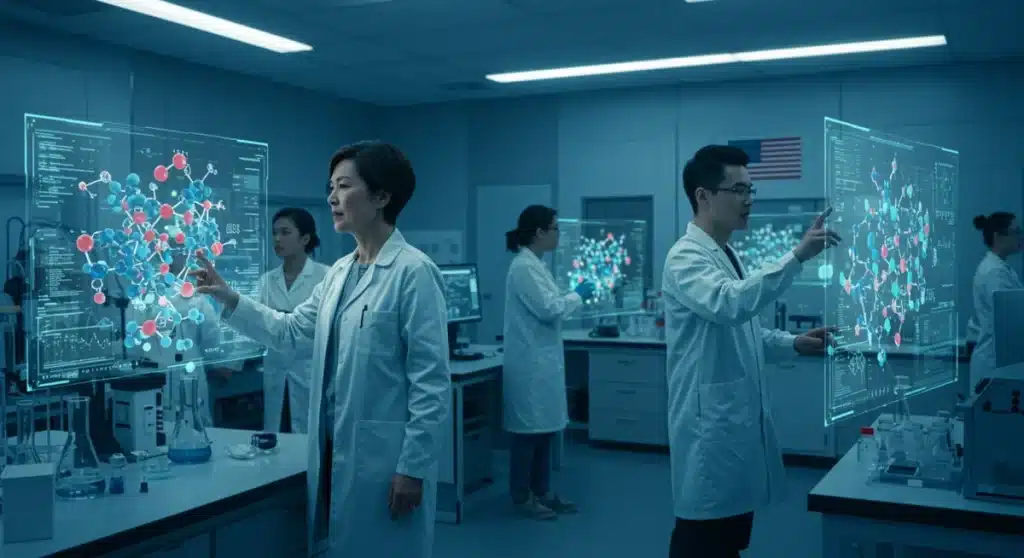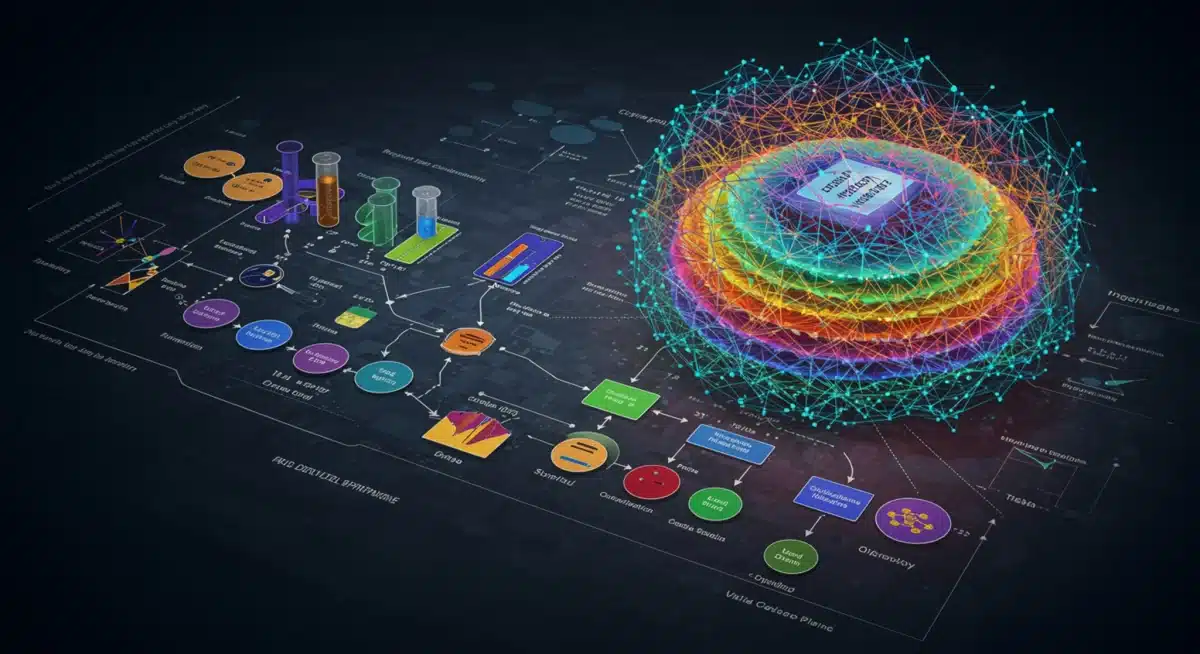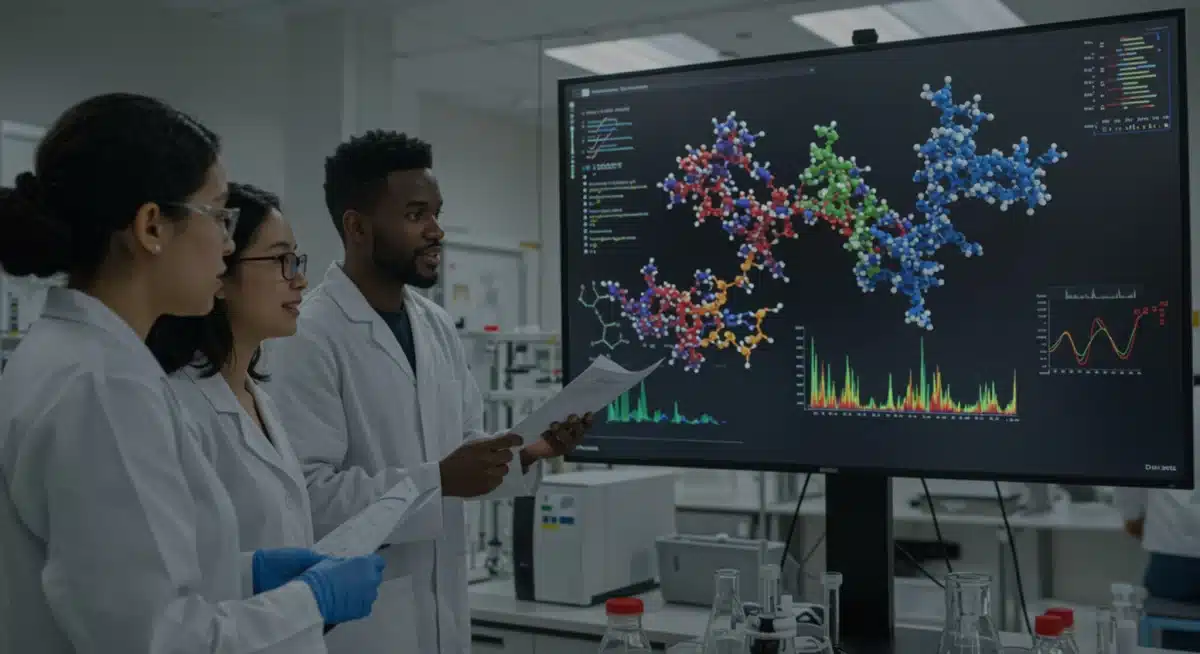AI-Driven Drug Discovery: Accelerating New Medicines in the US

AI-driven drug discovery is revolutionizing how pharmaceutical companies in the US identify, develop, and bring new medicines to market, significantly enhancing efficiency and reducing the timelines of traditional drug development.
The landscape of pharmaceutical innovation is undergoing a profound transformation, largely driven by the integration of artificial intelligence. In the United States, the adoption of AI-driven drug discovery is not just a trend; it’s a paradigm shift, promising to accelerate the development of new medicines at an unprecedented pace. This cutting-edge approach leverages sophisticated algorithms and vast datasets to revolutionize every stage of the drug development pipeline, from initial target identification to optimizing clinical trials.
The Dawn of AI in Pharmaceutical Research
The traditional drug discovery process is notoriously lengthy, costly, and fraught with high failure rates. It often takes over a decade and billions of dollars to bring a single new drug to market. The sheer complexity of biological systems and the immense chemical space to explore have historically presented formidable challenges. However, the advent of artificial intelligence is fundamentally changing this dynamic, offering powerful tools to navigate these complexities with greater precision and speed.
AI’s ability to process and analyze massive amounts of data, identify subtle patterns, and make predictions far beyond human capabilities is proving to be a game-changer. From genomics and proteomics to real-world patient data, AI can sift through information at an incredible scale, uncovering insights that were previously unimaginable. This technological leap is not merely an incremental improvement; it represents a complete rethinking of how we approach therapeutic development, particularly within the competitive and highly regulated US pharmaceutical market.
Early adoption of AI in pharmaceutical research has already shown promising results, with several AI-discovered compounds entering clinical trials. This success validates the potential of AI to not only streamline existing processes but also to open entirely new avenues for therapeutic intervention. The US, with its robust research infrastructure and significant investment in biotechnology, is at the forefront of this revolution, positioning itself as a global leader in AI-powered drug development.
Revolutionizing Target Identification and Validation
One of the earliest and most critical stages of drug discovery is identifying and validating biological targets – the specific molecules, pathways, or genes that a drug aims to influence. Misidentifying targets is a common cause of drug development failures. AI, with its advanced analytical capabilities, offers a powerful solution to this challenge.
Leveraging Genomic and Proteomic Data
AI algorithms can analyze vast repositories of genomic, proteomic, and transcriptomic data to pinpoint disease-associated targets with higher accuracy. This involves looking at:
- Gene expression patterns: Identifying genes that are over or under-expressed in diseased states.
- Protein-protein interactions: Mapping complex networks to find critical nodes for intervention.
- Biological pathways: Uncovering dysregulated pathways that contribute to disease progression.
By integrating diverse data types, AI can build comprehensive models of disease, offering a more holistic view than traditional methods. This leads to the identification of novel targets that might have been overlooked, increasing the chances of developing truly innovative therapies.
Furthermore, AI assists in validating these targets by predicting their tractability and potential side effects. Machine learning models can assess the likelihood of a target being ‘druggable’ based on its structural characteristics and known interactions. This early validation significantly reduces the risk of pursuing targets that are unlikely to yield successful drug candidates, saving considerable time and resources.
Accelerating Lead Compound Discovery and Optimization
Once a target is identified, the next step involves finding compounds that can effectively bind to and modulate its activity. This phase, known as lead discovery, traditionally relies on high-throughput screening (HTS) of large chemical libraries, a process that is both time-consuming and expensive. AI is transforming lead discovery by enabling more intelligent and efficient exploration of chemical space.

AI-powered computational methods, such as generative models and deep learning, can design novel molecules with desired properties from scratch. Instead of exhaustively testing existing compounds, AI can propose new chemical structures that are predicted to interact favorably with the target. This significantly narrows down the number of compounds that need to be synthesized and experimentally tested.
Virtual Screening and De Novo Design
Key AI techniques in this phase include:
- Virtual Screening: AI algorithms predict the binding affinity of millions of compounds to a specific target, prioritizing the most promising ones for experimental validation.
- Generative Chemistry: Deep learning models are trained on vast datasets of known drugs and molecules to generate entirely new chemical entities with optimized pharmacological properties.
- Property Prediction: AI can predict various physicochemical and ADMET (absorption, distribution, metabolism, excretion, and toxicity) properties of molecules, helping to avoid compounds with undesirable characteristics early on.
The optimization of lead compounds is equally critical, aiming to improve potency, selectivity, and pharmacokinetic profiles while minimizing toxicity. AI algorithms can iteratively suggest modifications to lead compounds, guiding chemists towards optimal structures with greater efficiency than traditional trial-and-error approaches. This iterative design process, often referred to as closed-loop optimization, accelerates the transition from lead identification to preclinical development.
Enhancing Preclinical Development and Toxicity Prediction
Preclinical development involves extensive testing of drug candidates in laboratory and animal models to assess their safety and efficacy before human trials. This stage is a major bottleneck, with many promising compounds failing due to unforeseen toxicity or lack of efficacy. AI is making significant inroads here, offering more accurate predictions and reducing the reliance on costly and time-consuming animal testing.
Machine learning models can analyze vast datasets of historical toxicology data, chemical structures, and biological assays to predict potential adverse effects of new drug candidates. This includes predicting organ toxicity, carcinogenicity, and off-target effects. By identifying problematic compounds earlier, AI helps researchers prioritize safer and more effective candidates, thereby streamlining the preclinical phase.
Furthermore, AI can optimize experimental design in preclinical studies, suggesting the most informative assays and animal models to gain maximum insight into a drug’s mechanism of action and safety profile. This intelligent design reduces the number of experiments needed and accelerates data generation, leading to faster decision-making.
The ethical implications of reducing animal testing are also significant. By providing more predictive in silico models, AI contributes to the 3Rs principle (Replacement, Reduction, Refinement) in animal research, aligning with growing societal and regulatory demands for more humane drug development practices.
Streamlining Clinical Trials and Patient Selection
Clinical trials represent the most expensive and time-consuming phase of drug development. Recruitment of appropriate patients, trial design, and data analysis are complex undertakings. AI is poised to revolutionize clinical trials by making them more efficient, cost-effective, and ultimately, more successful.
Optimizing Patient Recruitment and Trial Design
AI algorithms can analyze electronic health records (EHRs), genomic data, and other real-world data sources to identify suitable patients for clinical trials with greater precision. This targeted recruitment ensures that trials enroll patients who are most likely to respond to the investigational drug, increasing the statistical power and success rate of the study. AI can also help in:
- Predicting patient response: Identifying biomarkers that correlate with drug efficacy or adverse events.
- Optimizing trial sites: Recommending locations with high patient populations and experienced investigators.
- Personalized dosing: Suggesting individualized dosing regimens based on patient characteristics to maximize efficacy and minimize side effects.
Beyond patient selection, AI can assist in designing more adaptive and efficient clinical trial protocols. Machine learning models can simulate trial outcomes, identify potential risks, and suggest modifications to trial parameters to optimize their success. This includes determining optimal sample sizes, endpoints, and duration of studies, leading to faster trial completion and reduced costs.
The ability of AI to continuously monitor and analyze data generated during a trial also allows for real-time adjustments, ensuring patient safety and maximizing the information gained. This dynamic approach contrasts sharply with traditional, more rigid trial designs, offering greater flexibility and responsiveness.
The Economic and Societal Impact in the US
The implications of AI-driven drug discovery for the US pharmaceutical industry and healthcare system are profound. Economically, it promises significant reductions in the cost and time required to develop new drugs. This efficiency can translate into lower R&D expenditure, potentially leading to more affordable medicines and increased profitability for pharmaceutical companies.

Furthermore, the accelerated pace of innovation means that critical new treatments can reach patients faster. For diseases with high unmet medical needs, this speed can be life-changing. From novel antibiotics to personalized cancer therapies, AI is enabling the development of medicines that address previously intractable conditions, improving public health outcomes across the nation.
The US is already a hub for biotechnology and pharmaceutical innovation, and AI is further solidifying this position. Investment in AI research and development within the life sciences sector is booming, fostering a vibrant ecosystem of startups, academic institutions, and established pharmaceutical giants collaborating to harness the power of AI. This creates new job opportunities in data science, bioinformatics, and computational chemistry, contributing to economic growth and technological advancement.
However, challenges remain, including the need for robust regulatory frameworks to evaluate AI-generated data and AI-designed drugs, ensuring data privacy and security, and addressing the ethical considerations surrounding AI in healthcare. Despite these hurdles, the trajectory towards an AI-powered future for drug discovery in the US is clear, promising a new era of medical breakthroughs and improved patient care.
| Key Aspect | Brief Description |
|---|---|
| Accelerated Timelines | Significantly reduces the time from drug candidate identification to market entry. |
| Cost Reduction | Lowers R&D expenses by increasing efficiency and reducing failure rates. |
| Enhanced Precision | Improves accuracy in target identification, lead optimization, and toxicity prediction. |
| Novel Therapies | Enables the discovery of new drug candidates for previously untreatable conditions. |
Frequently Asked Questions About AI in Drug Discovery
AI accelerates drug discovery by rapidly analyzing vast datasets, identifying promising drug targets, designing novel molecules, and predicting their properties with greater accuracy than traditional methods. This significantly reduces the time spent on trial-and-error experimentation, streamlining the entire pipeline from research to development.
Key benefits include reduced R&D costs, shorter development timelines for new medicines, increased success rates in identifying viable drug candidates, and the ability to discover treatments for complex or rare diseases. AI also enhances precision in predicting efficacy and potential toxicity, leading to safer drugs.
No, AI is not replacing human scientists but rather augmenting their capabilities. AI acts as a powerful tool, handling data analysis and predictive modeling, allowing scientists to focus on experimental design, critical thinking, and complex problem-solving. It fosters a collaborative environment where human expertise is enhanced by AI’s computational power.
Challenges include the need for high-quality, standardized data, robust regulatory frameworks for AI-generated insights, ensuring data privacy and security, and integrating diverse AI tools into existing workflows. Ethical considerations and the high cost of initial AI implementation also represent significant hurdles for widespread adoption.
AI improves clinical trials by optimizing patient recruitment through precise identification of eligible candidates using real-world data. It also aids in designing more efficient trial protocols, predicting patient responses, and monitoring safety in real-time. This leads to faster, more targeted, and more successful clinical development phases.
Conclusion
The advent of AI-driven drug discovery marks a pivotal moment in the history of medicine. In the US, this innovative approach is rapidly reshaping the pharmaceutical landscape, offering unprecedented opportunities to overcome the traditional hurdles of drug development. By enhancing efficiency, reducing costs, and accelerating the timeline from concept to cure, AI promises to deliver a new generation of life-saving and life-improving medicines to patients faster than ever before. While challenges remain, the undeniable potential of AI to revolutionize healthcare solidifies its role as an indispensable tool for future pharmaceutical breakthroughs, fostering a healthier and more innovative future for the nation.





